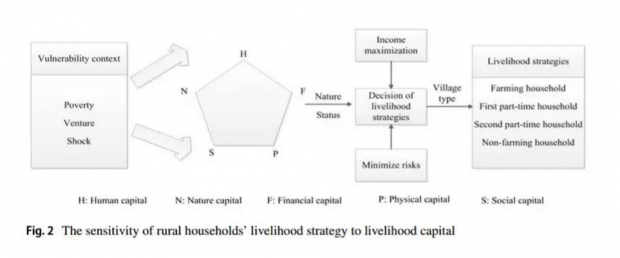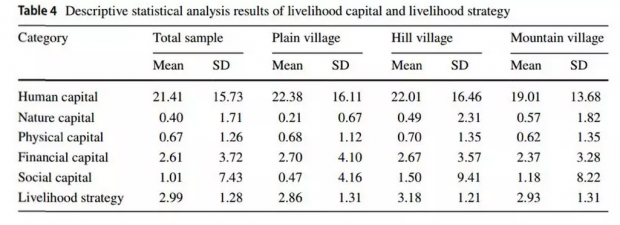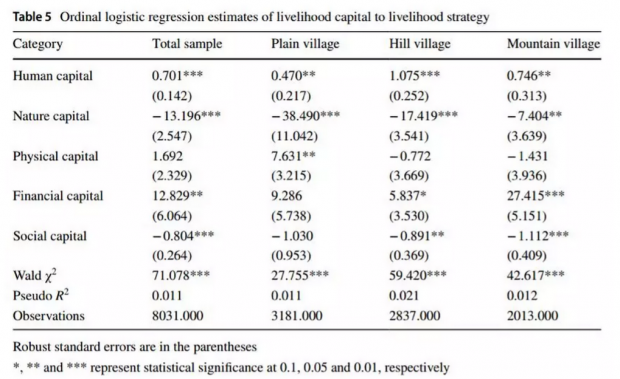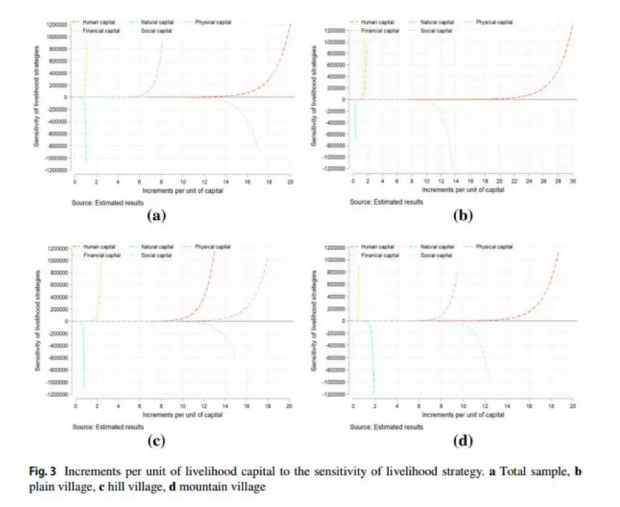阅读:0
听报道
推文人 | 邓鑫
原文信息:Xu et al. (2018). Sensitivity of Livelihood Strategy to Livelihood Capital: An Empirical Investigation Using Nationally Representative Survey: Data from Rural China. Social Indicators Research.
引言
伴随着快速的经济发展,城市化已经成为全球农村发展的趋势。与此同时,由于非农部门和农业部门的收入差距,许多国家农村家庭经历了收入结构和劳动力配置结构的变化。中国,作为世界上最大的发展中国家,也不例外。其主要表现为,城市化水平快速提高与农村家庭生计策略非农化。作者认为,随着农村家庭的不断分化,农户的生计资本与生计策略也在不断调整。由此,生计策略与生计资本的相关关系分析一直是地理学、管理学、经济学、生态学等学科的热点话题。然而,现有的微观实证研究主要基于一些小规模调查数据,缺乏以全国层面的大规模调查数据进行探索;同时,少有实证研究从村庄类型的角度探索来自不同类型村庄的农户家庭,其生计策略对生计资本的敏感性。通过文献梳理,作者提出两个关键科学问题:
1.不同类型村庄中农户家庭的生计资本和生计策略有哪些特点?
2.不同类型村庄中农村家庭生计策略对各类生计资本的敏感性表现如何?
理论框架
基于可持续生计框架,作者提出由于资源禀赋、地理区位的差异,不同类型村庄(平原、丘陵和山区)中的农户家庭在生计资本和生计策略选择上存在差异,生计策略对生计资本的敏感性也是不同的。例如,与山区村庄相比,平原村庄地势更加平坦,区位优势更加明显,机械化利用率更高,从而可以更容易地实现农业生产规模化。这使得平原村和山区村庄的农村家庭拥有不同的生计资本结构,并做出不同的生计策略决策。

数据来源及计量模型
该文数据来自于中山大学社会科学调查中心2014年组织的中国劳动力动态调查(China Labor-force Dynamic Survey,简称CLDS)。通过数据清洗整理工作,该文最终使用了其中27个省(市、自治区)226个村8031户农户的调查数据。其中,平原村89个;丘陵村80个;山区村57个。
此外,该文首先对不同种类生计资本的二级指标进行标准化处理;尔后使用熵权法对二级指标赋权,计算不同种类生计资本的综合水平;最后采用有序多分类logit回归模型来探索农村家庭生计策略对各类生计资本的敏感性。
结果发现
1. 不同类型村庄中农户家庭的生计资本和生计策略的特点

不同类型村庄中农户家庭都以非农就业作为主要的生计策略选择。

人力资本,是不同类型村庄中农户家庭最重要的生计资本。
2. 不同类型村庄中农村家庭生计策略对各类生计资本的敏感性表现
对于总样本,人力资本和金融资本对生计策略有正而显著的影响。从相关系数和敏感性曲线的陡峭程度而言,农村家庭生计策略对金融资本的敏感性远高于人力资本。对于平原村样本,人力资本和物质资本对生计策略有正而显著的影响。从相关系数和敏感性曲线的陡峭程度而言,农村家庭生计策略对物质资本的敏感性远高于人力资本。对丘陵村和山区村样本,其结果与总样本相似。


政策启示
作者认为:①出台改善农户家庭生计能力的相关政策时,应当充分考虑村庄的类型差异,重点改善最贫困人口的生计资本结构。②政府应当继续增加教育资金投入,持续改善农户的人力资本,带动生计策略调整。③三种类型村庄中,针对平原村农户对物资资本敏感的特点,应重点推动土地流转和机械化使用,实现土地适度规模经营,进而带动生计策略优化;针对丘陵村和山区村农户对社会资本敏感的特点,应重点给予一定的人才政策支持,鼓励优秀农民工返乡创业,进而带动周边农户优化生计策略。
Abstract
Research on the association between rural households’ livelihood capitals and livelihood strategies has long been of interest in geography, management, economics, ecology and other disciplines. However, the existing micro-empirical studies are mostly small-scale surveys of rural households; there are much fewer large-scale investigations at the national level. Meanwhile, few empirical studies have analyzed the sensitivity of rural households’ livelihood strategies to various types of livelihood capitals in different types of villages, from the perspective of village type. This study uses survey data from 8031 rural households in 226 villages from 27 provinces (cities) of China; the villages were divided into three types: plain villages, hilly villages and mountainous villages. The livelihood capitals and livelihood strategies of rural households in different types of villages were examined, and ordinal logistic regression models were construed to explore the sensitivity of rural households’ livelihood strategies to various types of livelihood capitals in different types of villages. The results revealed that: (1) the sample of rural households had similar livelihood asset structures and livelihood strategy selections across the different types of villages. Among them, human capital was the most important livelihood asset for rural households, while rural households had the lowest dependence on natural capital; of-farm work was the main livelihood strategy for rural households, followed by on-farm work, while the proportion of households engaged in part-time work was the smallest. (2) Rural households’ livelihood strategies had different sensitivities to various types of livelihood capitals, and there were also differences in the sensitivities among different types of villages. For the total sample, as well as the hill and mountain village sub-samples, human and financial capitals had significant positive impacts on livelihood strategy, while nature and social capitals had significant negative impacts on livelihood strategy; physical capital had no significant impact on livelihood strategy. For the plain village sub-sample, human and physical capitals had significant positive impacts on livelihood strategy, while nature capital had a significant negative impact on livelihood strategy; financial and social capitals had no significant impacts on livelihood strategy. This study enhances our understanding of the characteristics of rural households’ livelihood capital structures and livelihood strategy selections as well as the sensitivity of rural households’ livelihood strategies to various types of livelihood capitals among different types of villages in China. These findings provide reference for the formulation of policies related to the improvement of rural households’ livelihoods in different types of villages.

话题:
0
推荐
财新博客版权声明:财新博客所发布文章及图片之版权属博主本人及/或相关权利人所有,未经博主及/或相关权利人单独授权,任何网站、平面媒体不得予以转载。财新网对相关媒体的网站信息内容转载授权并不包括财新博客的文章及图片。博客文章均为作者个人观点,不代表财新网的立场和观点。




 京公网安备 11010502034662号
京公网安备 11010502034662号 